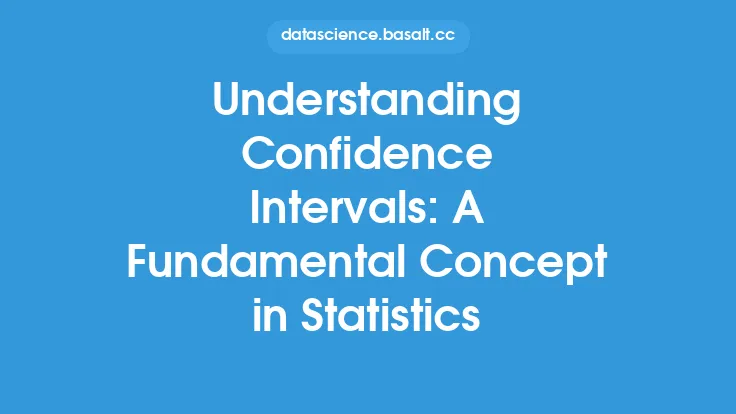Introduction to Confidence Intervals for Proportions
In statistical analysis, estimating population parameters is a crucial task. One of the key parameters of interest is the population proportion, which represents the proportion of individuals or items in a population that possess a certain characteristic. Confidence intervals for proportions provide a range of values within which the true population proportion is likely to lie. This statistical tool is essential in various fields, including medicine, social sciences, and business, where understanding the proportion of a population with a specific attribute is vital for decision-making and policy development.
Understanding the Concept of Confidence Intervals for Proportions
A confidence interval for a proportion is constructed using the sample proportion, which is the proportion of individuals or items in a sample that possess the characteristic of interest. The sample proportion is used as an estimate of the population proportion. The confidence interval is calculated using a formula that takes into account the sample proportion, the sample size, and the desired confidence level. The confidence level, usually denoted as (1 - α), represents the probability that the confidence interval contains the true population proportion. For example, a 95% confidence interval means that if the same sample were taken multiple times, 95% of the resulting confidence intervals would contain the true population proportion.
Calculating Confidence Intervals for Proportions
The calculation of a confidence interval for a proportion involves several steps. First, the sample proportion (p̂) is calculated as the number of successes (x) divided by the sample size (n). Then, the standard error of the proportion (SE) is calculated using the formula SE = √(p̂(1-p̂)/n). The margin of error (E) is determined by the desired confidence level and is typically found using a z-score or t-score from a standard normal distribution or t-distribution, respectively. For large samples, the z-score is commonly used, and the formula for the confidence interval is p̂ ± z * SE, where z is the z-score corresponding to the desired confidence level. For smaller samples, the t-score may be used, especially when the sample size is less than 30.
Assumptions and Considerations
When constructing confidence intervals for proportions, several assumptions and considerations must be taken into account. One key assumption is that the sample is randomly selected from the population, ensuring that each individual or item has an equal chance of being included. This randomness helps to minimize bias and ensures that the sample proportion is a reliable estimate of the population proportion. Another consideration is the sample size. Generally, larger samples provide more precise estimates of the population proportion. However, the required sample size can depend on the desired margin of error and the confidence level. It's also important to note that confidence intervals for proportions are sensitive to the sample size and the proportion itself, particularly when the proportion is close to 0 or 1.
Interpretation of Confidence Intervals for Proportions
Interpreting confidence intervals for proportions involves understanding what the interval represents. The confidence interval provides a range of plausible values for the population proportion. If the confidence interval is wide, it indicates that there is a lot of uncertainty about the true population proportion, suggesting that a larger sample size might be needed for more precise estimates. Conversely, a narrow confidence interval indicates less uncertainty and suggests that the sample proportion is a more reliable estimate of the population proportion. It's also crucial to consider the confidence level when interpreting the interval. A higher confidence level (e.g., 99%) will result in a wider interval compared to a lower confidence level (e.g., 90%), reflecting the increased probability that the interval contains the true population proportion.
Applications of Confidence Intervals for Proportions
Confidence intervals for proportions have numerous applications across various disciplines. In medicine, they are used to estimate the prevalence of diseases, the effectiveness of treatments, and the proportion of patients responding to a particular therapy. In social sciences, confidence intervals for proportions help in understanding public opinions, behaviors, and demographic characteristics. In business, they are applied in market research to estimate the proportion of customers who prefer certain products or services. Confidence intervals for proportions also play a critical role in quality control, where they are used to monitor the proportion of defective products in a manufacturing process.
Advanced Topics and Complexities
For more complex scenarios, such as estimating proportions in stratified or clustered samples, specialized methods and formulas are required. These might involve adjusting the standard error to account for the design effects of the sampling strategy. Additionally, when dealing with small samples or proportions close to 0 or 1, alternative methods such as the Wilson score interval or the Clopper-Pearson interval may provide more accurate confidence intervals. These advanced topics highlight the complexity and nuance of statistical estimation and the importance of selecting the appropriate method based on the research question and data characteristics.
Conclusion
Confidence intervals for proportions are a fundamental statistical tool for estimating population parameters with precision. They provide a probabilistic range within which the true population proportion is likely to lie, allowing researchers and practitioners to make informed decisions based on sample data. Understanding how to calculate, interpret, and apply confidence intervals for proportions is essential for anyone working with statistical data. By considering the assumptions, limitations, and appropriate applications of confidence intervals for proportions, individuals can harness the power of statistical inference to better understand their data and the populations they represent.





